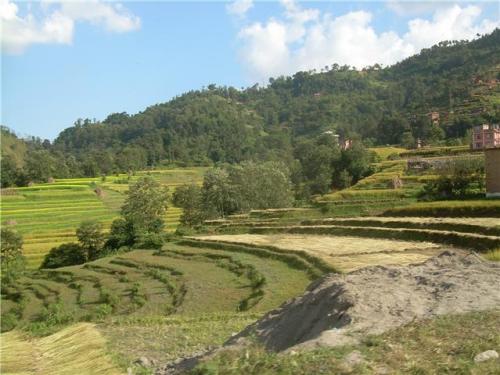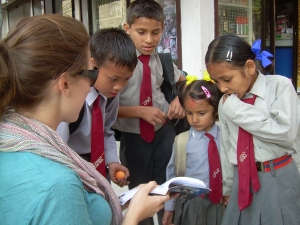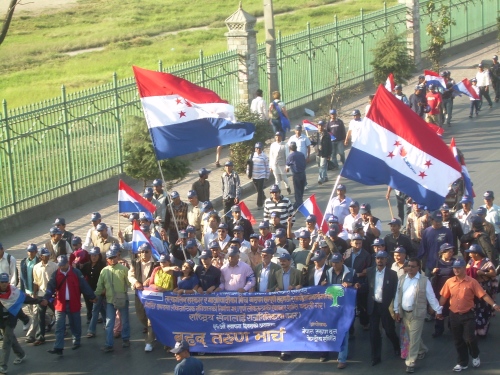Click here to see where we hiked.
From the first time I realized we would be coming to Nepal, I knew I  wanted to do one of the famous tea-house treks. A “trek” is kind of like what we’d call a backpacking trip back home: heading off into the boonies to do some hiking and camping. But in this part of the world “backpacking” is traveling cheaply while living out of a backpack, so the names are changed around a bit. Terminology aside, trekking in Nepal is different from almost anywhere in the world. Not only is the Himalayan setting and scenery uniquely spectacular, but the so called tea-house treks offer what I’d call a more refined approach to a hiking trip: rather than camping out and cooking for yourself, all along the trail are a series of lodges and restaurants that take care of all your food and shelter needs. All you really need to carry is a sleeping bag and clothing; no food, shelter, stove, fuel, and the myriad other things you need on a standard camping trip. That means a nice, light backpack, which is always a good thing but is even better than usual in that thin Himalayan air. Last summer Denae and I spent a month hiking and camping 400 miles across Oregon on the Pacific Crest Trail so we’re no strangers to self-supported trips, but this tea-house style of trekking was sounding like a lot of fun to us.
wanted to do one of the famous tea-house treks. A “trek” is kind of like what we’d call a backpacking trip back home: heading off into the boonies to do some hiking and camping. But in this part of the world “backpacking” is traveling cheaply while living out of a backpack, so the names are changed around a bit. Terminology aside, trekking in Nepal is different from almost anywhere in the world. Not only is the Himalayan setting and scenery uniquely spectacular, but the so called tea-house treks offer what I’d call a more refined approach to a hiking trip: rather than camping out and cooking for yourself, all along the trail are a series of lodges and restaurants that take care of all your food and shelter needs. All you really need to carry is a sleeping bag and clothing; no food, shelter, stove, fuel, and the myriad other things you need on a standard camping trip. That means a nice, light backpack, which is always a good thing but is even better than usual in that thin Himalayan air. Last summer Denae and I spent a month hiking and camping 400 miles across Oregon on the Pacific Crest Trail so we’re no strangers to self-supported trips, but this tea-house style of trekking was sounding like a lot of fun to us.
We’d decided to do the 200 kilometer Annapurna Circuit trek in central Nepal, one of the more popular longer treks due to it’s reputation for varied scenery and culture, and the amazing trip over
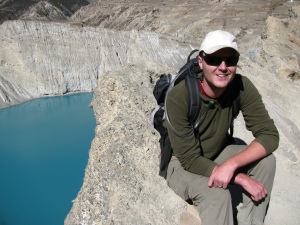
Andy on a day hike above Manang
the nearly 18,000′ Thorung La pass. This is not a trip through wilderness, like a backpacking trip we’d take back home. Nepal is a fairly small country with about 20 million people, and the majority of its population is distributed throughout its rural areas, including the one we were hiking through. Most of the lower altitude land that could support crops was terraced and planted, and there were homes or at least signs of people almost all along the way, along with a series of villages and towns. This wasn’t a deterrent for us; we wanted to see the rural culture of the area that had such a great reputation. People and towns along the way also meant amenities, so this wouldn’t be a trip of self-deprivation: the nickname for the trek is the Apple Pie trail, thanks to the availability of that and other delectables along the way. It sounded pretty good to us.
We set off armed with sleeping bags, down coats and some other warm clothing for the cold that we’d find at the higher altitudes, but at the beginning of the trip during the daytime the clothes were far
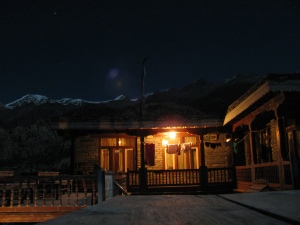
A night shot at one of our guesthouses
from necessary. We never realized it before we came, but Nepal sits at latitudes that are approaching the tropics- about the same as Florida, we were told. So even in November, at lower altitudes the sun beats down with some serious heat. We were thankful for our brimmed hats, bandannas and shorts at that time- not our down gear. But that would change as we climbed higher. It did get surprisingly cold, even at the beginning of the trip, when the sun went down. The sun always set surprisingly quickly, and as soon as it did the temperature would instantly plummet, leaving us scrambling for our fleeces when moments before we’d been basking in T-shirts.
To get to the starting point for the trek we rode a local bus about five hours from Pokhara to a small town called Besisahar, found a cheap guest house for the night, and the next morning started walking. The permits that we’d paid for in Pokhara (a little spendy at over $50 usd for the two of us) were checked here at the beginning as well as at various places throughout the trip. Our bags were light, the sun was shining, and we were excited to get underway.
Our first day of walking was during election night at home. We kept asking people along the way if they had a TV, or had heard anything, but nobody had. Finally we staggered into our guesthouse for the evening, and tracked down the owner to ask if he had a television. He looked at us knowingly and said, more a statement than a question, “you’re Americans?” We nodded, and he told us that Obama had won in a landslide. Everyone was pretty happy (and ever since then most every Indian’s first words upon hearing where we’re from are “America? Ah, Obama!!”).
The first few days of the trek were through a lush, almost jungly river

Terraced Hills
canyon. There were mountains off in the distance that we would occasionally glimpse, but most of the scenery consisted of huge hillsides terraced out for rice farming. There were literally hundreds of little terraces going over 1000 vertical feet up some of these steep hills; it would be a humbling sight for the average farmer back in the states who has hundreds of flat, fertile acres and modern irrigation. The river down below was beautiful, and periodically we would pass large waterfalls spilling off from the hillsides on either side of us. We crossed rickety suspension bridges high over streams and canyons, and dodged numerous mule trains.
We spent our nights at simple guest houses, where we always found an inexpensive double room with an outhouse outside. Some rooms
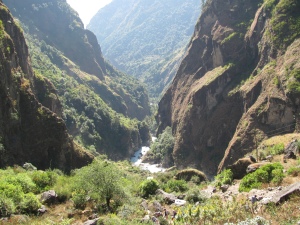
Some lower altitude scenery
were divided from the others by walls made out of little more than cardboard, while others were essentially the same buildings we’d been staying at in the cities. The lodging was always very cheap, anywhere from free to a couple dollars. The food, however, was expensive. As we got further and further from anywhere that a truck could deliver goods, food became more and more costly. This is understandable, as much of it has to be carried in, but there was definitely some price gouging going on. Expensive definitely didn’t always mean good, either, and sometimes ordering continental food would produce something just plain weird (this is true all over south Asia, though): once when Denae ordered mashed potatoes, she received a bowl of shredded potatoes that had been boiled down with milk to a thin, glue like consistency, and then sugared heavily. We grumbled, but at least we weren’t carrying it, not to mention having it cooked and cleaned up for us.
We did save some money by carrying some supplies that we’d bought in Pokhara: 24 snickers bars and two small tubs of peanut butter. The snickers would later draw some envious looks from our fellow trekkers when the lodges were charging 250 rupees (about $3.20 usd, a ton of money for Nepal!) for one candy bar.
Our constant companions along the trail were the Nepalese porters,

A porter carrying live chickens
whose bags were far from light. These guys were usually wearing plastic flip-flop scandals, staggering underneath gigantic loads of everything from rebar to live chickens. Many of them were carrying 80 pounds or more, sometimes a lot more. Roads are starting to be built in places like the Annapurna Circuit (more on that later) but for the most part everything- fuel, soda pop, food that isn’t grown locally, building materials, everything– has to be carried in on someone’s back, or on what must be much more expensive mule trains.
Many trekkers in Nepal employ local porters and/or guides to help show them the way and carry their stuff. This practice is definitely encouraged by the Nepalese as it is an important revenue source for their economy, and the work is relatively well paid at somewhere in the neighborhood of $10-20 usd per day (that’s a very approximate figure; we didn’t really look into it). We didn’t use a porter or guide. We both figured it would feel a little uncomfortable and colonial to have someone else carry our gear, although the locals definitely don’t look at it that way. I know how to use a map and compass pretty well, and the trail was reportedly so well traveled and inhabited that finding the way would never be a problem. The cost of hiring someone wasn’t completely prohibitive, but over twenty or so days it was pretty expensive. Most of all, though, we are simply too independent. We met a lot of people along the way whose porter/guide was really calling the shots- where to stay for the night, when to stop for tea or rest, which of the alternate routes to take, that kind of thing. We would hate that, and never regretted our decision to go it alone, but did talk to many people who felt their experience was greatly augmented by having someone there to explain local culture, interpret, etc.
Anyone who does hire someone for a trek should definitely get him from a reputable agency, so there is some kind of guarantee that

One of the many small villages we passed through
things will go OK, or at least have some recourse if they don’t. We ran into a group of Israelis who had casually hired a porter they’d met along the way. They didn’t know any more about him than his first name, and when he’d turned out to be a drunk and a thief they had no one to complain to when they fired him. Even worse, he’d become so close to violent upon being let go that they’d felt compelled to pay his wage for 20 days, even though he’d only been with them for 5. Even after being paid off he told them to keep their eyes open on the trail for the next couple days, because he and some friends were going to take them out! We always felt safe, but Nepal is just emerging from a decade of conflict that killed thousands of people, so a threat like that isn’t something to dismiss without worrying about it. Thankfully it all turned out to just be bluster, but the Israelis (fresh from the army lads who I sure wouldn’t have messed with, by the way) were pretty nervous for a while.
The route of the trek climbs pretty consistently from the beginning on towards the huge Thorung La pass, and as we gained elevation day by day the terrain and vegetation changed dramatically. Soon we passed through the rice paddies and thick greenery, and came to a kind of mid-alpine area full of evergreens and hardwood trees that really reminded us of home in the fall. There was one point when we both turned to each other and said, almost at the same time, that we felt like we were back at Mt. Pisgah in Oregon, where we’d gotten married a few months earlier. An hour later a guy said he’d seen a large white monkey walking through the forest. We thought… Yeti?
Soon we made our way to a high alpine zone, and suddenly it felt like we were really in the Himalayas. Huge soaring hills of solid rock were everywhere, there were much less trees and vegetation, the air was thinner and cold, and dominating everything were the mountains. All around us were some of the tallest peaks in the world, covered with snow and huge glaciers and towering an incredible distance above us. Every day we walked the scenery grew more and more amazing.
The town of Manang was a highlight. Trekkers spend a rest day here at 11,500′ to help acclimatize for the big pass a few days later. This is the big city for the locals, complete with bakeries and movie showings.
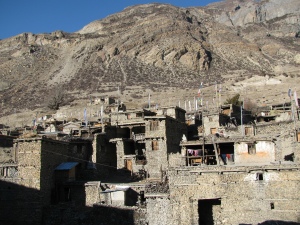
Some of Manang's old buildings
We enjoyed a nicer than usual guest house, great food (the yak burger was just OK…) and the old part of the town that reminded us a lot of Leh in Ladakh with its mud brick construction and Buddhist flavor. There was also some fantastic day hiking. We walked up to a nearby viewpoint that overlooked a glacial lake and the biggest glacier we’d ever seen in person. It tumbled off of one of the nearby mountains, down to the valley floor where it formed a stream down to the lake. I hiked to the foot of the glacier and it was incredible to see so much pure ice. It seemed huge and up so close I could probably only see 5% of it, maybe less!
After Manang we left the road behind. Roads on these trekking routes

Denae in front of the big glacier near Manang
are controversial, to say the least. While they represent progress to some Nepalis, they are a huge eyesore and detriment to the experience of most of the trekkers who are the lifeblood of the economy for the area. Porters, guides, guesthouses, restaurants, and many others all depend on a steady supply of foreign trekkers and their relatively deep pockets to come through each year, and they are more than a little put off by roads. We talked to many locals who said their business was way down, and more and more trekkers were going elsewhere in search of the road-free experience the Annapurna Circuit used to be. The road from Besishar at the beginning of the trek goes all the way to Manang, but thankfully (for us, anyway) the monsoon landslides, as they often do, had taken the road out only a couple days into the trek and there was no traffic beyond that point. Unfortunately the trail in many stretches was the road, a much less scenic alternative to the old footpaths that had been used for centuries.
The roads were one of a few disappointments we had on this trip, the other big one being the general attitude of many of the locals. Like many other places we’ve been on this trip, a high percentage of the people we met made their livings off of tourists, and quite blatantly viewed us as nothing more than walking wallets. We’d start to feel very jaded when for days at a time we’d fail to have one meaningful interaction with a local, but then a man wearing wool robes would come out and bashfully show us his son, wanting nothing more from us than some cultural interaction. Moments like that, along with the sublime natural beauty of the area, kept us from ever feeling too down. We had hoped that out there in the boonies people would be less jaded about tourism, but in retrospect it isn’t surprising that that was the case. I can imagine that if the only possible way I could earn more than a pittance of money was to put up with- and serve, often in a very mean fashion- a bunch of sometimes very obnoxious tourists tromping through my hometown, I would get pretty bitter too.
From Manang we headed upward, dodging large organized groups of graying and plump French people who had a team of porters carrying all their crap, which we later heard included french cheeses and

Denae on the way up the pass
bottles of wine! We managed to be both contemptuous and jealous at the same time. By this time we’d randomly run into a Canadian couple we’d met on a bus earlier in our trip, in Ladakh; we even mentioned them in our blog back then. Small world! It was getting cold as we climbed higher and higher, even in the mid day sun, and during the mornings and evenings we were very thankful for our warm clothing. The mountain scenery was downright spectacular, as were the food prices at the remote guest houses leading up to the pass. We saw lots of Yaks (or dzos, yak-cow hybrids, we can’t tell the difference) grazing on the hillsides, and sometimes what looked like full on cliffsides; they are surefooted animals.
Finally it was time for the final push up the 17,769′ Thorung La pass.

Our prayer flags are in that pile somewhere...
We left our guest house at the foot of the climb at 6:30am, much later than many people, some of whom left at 3 or even 2am (they were very slow and/or insane!). There was little to no snow on the trail, and we were happy not to use the gators and plastic bag vapor barriers that we’d brought in case we had to post hole through snow with our trail runner shoes. We made good time and reached the top around 10am. It was a stiff hike, but we felt no ill effects from the altitude, which can be very dangerous and has killed people on this route. Actually for us the pass was pretty easy, certainly no harder than climbing up the South Sister or something like that. The pass was probably the high point for scenery on the trip, as well as elevation, and we stared in awe all around us at the mountain views. We’d carried in some prayer flags from Pokhara and strung them up with all the others fluttering in the wind. We bought some 100 rupee black tea (!) from the improbably situated shack that seemed to be doing brisk business in the cold wind, took some photos, and started down the other side.
Unfortunately the descent down the other side is probably harder than the climb. It drops steeply down for over 4000′ vertical feet, really pounding one’s knees and leg muscles. Denae had been suffering from some serious knee pain over the last week, and the trip down the pass had her hurting pretty badly. We made it down, though, and celebrated with some friends we’d met along the way by drinking a few beers at the next town we came to.
The guest house we stayed in there was the scene of one of our more unique experiences on the trip. When we asked for a room the owner lady only had a triple bed room available, and we agreed we’d take it but at a double price. Five minutes later I was sitting on the bed in my underwear when she barged in with two trekkers in tow. She looked at us in confusion for about thirty seconds, then said in suprise, “Oh, you’re full?” The other trekkers looked confused and horrified, and finally we convinced her that yes, we were indeed full, and she left. After all that, we were warned not to eat there by a fellow trekker, who said that his porter wouldn’t eat the Dahl Baht (rice and lentils) that they served him. This is quite a statement, as most Nepalis eat dahl baht twice a day, every day, and porters work up quite the appetite. So we ate at the neighboring guest house, in violation of the sacred (to the guest house owners) rule that lodgers eat where they sleep, which is really how the guest houses make their money. Anyway the owner lady went crazy! We later found out that she is an alcoholic and gets kind of crazy on a regular basis, but she got into a screaming match with some of our friends and tried to refuse them entry, even though they had already taken a room and had all their stuff in there. That night when we went down to use the bathroom, she was waiting in the dark hallway and started yelling at us, “you don’t eat here, you don’t sleep here!” She was pretty pissed (in more than one sense of the word), but I just said OK, we’re just going to use the bathroom and then go to bed, you go away now. And she did.
Denae’s knee was in a sorry state. Walking downhill had been what hurt it the most, and the huge descent down the pass had put a massive amount of stress on it. She woke up the following morning hardly able to walk, so we told the friends we’d been hiking with for the last week or so that we wouldn’t be able to keep up and they should go on ahead. We slowly made our way, with Denae hobbling gamely onward, and late that day made it to Jomson, the biggest town on the trek. We found comfortable guest house with a TV and a huge pile of Newsweeks from 2003 (among the more interesting articles in that bizarre literary time warp: how European countries were embarrassed and having to eat their words for opposing the United State’s Iraq war, which the US had just so successfully and easily won! Crazy!!!). We decided to stay for a rest day to see if it would help Denae’s knee heal a bit, because at this point she was barely making it up and down the stairs. We enjoyed vegging out, but the following day the knee wasn’t any better. We started hiking anyway, but at this point we were walking on another road, this time with plenty of traffic. Denae was hurting, jeeps were clunking by, and we kind of realized that given the circumstances it was foolish for her to keep hiking and risk doing permanent damage to the knee. We walked back to the jeep stand and caught a ride on the roof of one of the outgoing rigs.
We still had some more jeeps and busses to catch in between washouts on the road, and some more hiking and a few more nights in guest houses, but essentially the trek was over for us at this point. It had been a fantastic time, and all told we were out there for about 17 days, through some of the most beautiful country we’d ever seen. We’d reccomend it to others as a good trip, with a few caveats, the biggest one being that you’d better do it soon! The roads really mess with the experience, and they are encroaching further and further into the boonies with every year.



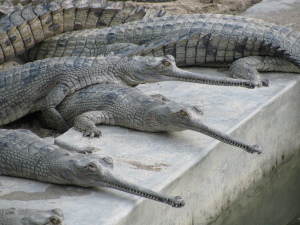



 wanted to do one of the famous tea-house treks. A “trek” is kind of like what we’d call a backpacking trip back home: heading off into the boonies to do some hiking and camping. But in this part of the world “backpacking” is traveling cheaply while living out of a backpack, so the names are changed around a bit. Terminology aside, trekking in Nepal is different from almost anywhere in the world. Not only is the Himalayan setting and scenery uniquely spectacular, but the so called tea-house treks offer what I’d call a more refined approach to a hiking trip: rather than camping out and cooking for yourself, all along the trail are a series of lodges and restaurants that take care of all your food and shelter needs. All you really need to carry is a sleeping bag and clothing; no food, shelter, stove, fuel, and the myriad other things you need on a standard camping trip. That means a nice, light backpack, which is always a good thing but is even better than usual in that thin Himalayan air. Last summer Denae and I spent a month hiking and camping 400 miles across Oregon on the Pacific Crest Trail so we’re no strangers to self-supported trips, but this tea-house style of trekking was sounding like a lot of fun to us.
wanted to do one of the famous tea-house treks. A “trek” is kind of like what we’d call a backpacking trip back home: heading off into the boonies to do some hiking and camping. But in this part of the world “backpacking” is traveling cheaply while living out of a backpack, so the names are changed around a bit. Terminology aside, trekking in Nepal is different from almost anywhere in the world. Not only is the Himalayan setting and scenery uniquely spectacular, but the so called tea-house treks offer what I’d call a more refined approach to a hiking trip: rather than camping out and cooking for yourself, all along the trail are a series of lodges and restaurants that take care of all your food and shelter needs. All you really need to carry is a sleeping bag and clothing; no food, shelter, stove, fuel, and the myriad other things you need on a standard camping trip. That means a nice, light backpack, which is always a good thing but is even better than usual in that thin Himalayan air. Last summer Denae and I spent a month hiking and camping 400 miles across Oregon on the Pacific Crest Trail so we’re no strangers to self-supported trips, but this tea-house style of trekking was sounding like a lot of fun to us.













 slowly separating the rice grains they had grown from the straw it was attached to with wicker sieves. On one of these walks Andy stopped at a small barber’s shack where he had decided to get a hair cut and shave. These barber shops are men only territory so I sat outside and gambled a few rupees away with some children. When Andy finally walked out of the shop a good half an hour later I knew something was terribly, terribly wrong by taking one look at his sad face. The barber had actually shaved off part of his hair in the back so you could see his white scalp which had never before seen the light of day. He also ended up with what Andy calls the ‘Friar Tuck’ style bangs. Hilarious? Yes! Now he wont get a haircut without me there to supervise.
slowly separating the rice grains they had grown from the straw it was attached to with wicker sieves. On one of these walks Andy stopped at a small barber’s shack where he had decided to get a hair cut and shave. These barber shops are men only territory so I sat outside and gambled a few rupees away with some children. When Andy finally walked out of the shop a good half an hour later I knew something was terribly, terribly wrong by taking one look at his sad face. The barber had actually shaved off part of his hair in the back so you could see his white scalp which had never before seen the light of day. He also ended up with what Andy calls the ‘Friar Tuck’ style bangs. Hilarious? Yes! Now he wont get a haircut without me there to supervise.





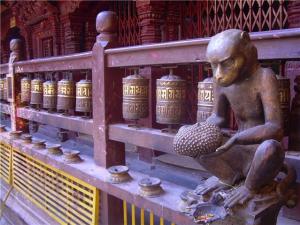 metal workers who are commissioned throughout Nepal to create a wide variety of religious art. On the streets surrounding the square there were many shops packed with art of all kinds, but since we were a little limited on room we only window shopped.
metal workers who are commissioned throughout Nepal to create a wide variety of religious art. On the streets surrounding the square there were many shops packed with art of all kinds, but since we were a little limited on room we only window shopped.
